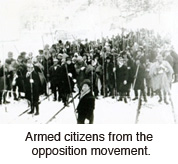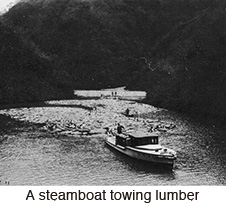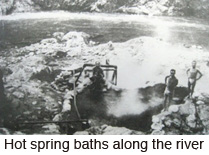Home > Story
The Gokayama Area
 Along the upper stream of the Shogawa River is the Gokayama region. Today, the historic gassho-style villages found in this area are registered World Heritage sites, and people visit from all over the world, but things were quite different 40-50 years ago.Transportation to the area was extremely limited, and people sometimes joked that “not even birds could reach it.” Especially during the winter, the heavy snowfalls prevented outside contact for over half of the year. This remote area was used as a prison for banished samurai of the Kaga clan, and it is said that as many as 150 people who had committed crimes were sent here. The Kaga clan also encouraged villagers to make saltpeter (an ingredient for gunpowder) in the ground floor of their houses. The saltpeter produced there was of the highest quality in Japan.
Along the upper stream of the Shogawa River is the Gokayama region. Today, the historic gassho-style villages found in this area are registered World Heritage sites, and people visit from all over the world, but things were quite different 40-50 years ago.Transportation to the area was extremely limited, and people sometimes joked that “not even birds could reach it.” Especially during the winter, the heavy snowfalls prevented outside contact for over half of the year. This remote area was used as a prison for banished samurai of the Kaga clan, and it is said that as many as 150 people who had committed crimes were sent here. The Kaga clan also encouraged villagers to make saltpeter (an ingredient for gunpowder) in the ground floor of their houses. The saltpeter produced there was of the highest quality in Japan.
Gokayama Folk Songs
 800 years ago, Taira clan soldiers sought refuge and settled in Gokayama, barely escaping alive after a defeat during the war between the Taira and Minamoto clans. They sang songs called “Mugiya-bushi,” reminiscing of their clan’s ancient glory.
800 years ago, Taira clan soldiers sought refuge and settled in Gokayama, barely escaping alive after a defeat during the war between the Taira and Minamoto clans. They sang songs called “Mugiya-bushi,” reminiscing of their clan’s ancient glory.  Along with “Kokiriko,” said to be Japan’s oldest folk songs, the “Mugiya-bushi” were carried down from generation to generation and are still performed today. This is why Gokayama is nicknamed the “Treasure Trove of Folk Songs.”
Along with “Kokiriko,” said to be Japan’s oldest folk songs, the “Mugiya-bushi” were carried down from generation to generation and are still performed today. This is why Gokayama is nicknamed the “Treasure Trove of Folk Songs.”
Logging along the river
 Since before the 16th century, loggers took advantage of the Shogawa River’s powerful current to transport lumber downstream from the Hida and Gokayama regions. The lumber was then collected for sale all over Japan.
Since before the 16th century, loggers took advantage of the Shogawa River’s powerful current to transport lumber downstream from the Hida and Gokayama regions. The lumber was then collected for sale all over Japan.
Construction on the Komaki Dam
 In 1914, with the outbreak of World War I, Japan experienced an unprecedented period of economic expansion. This lead to the modernization of manufacturing, and a great demand for electricity. Toyama industrialist Soichiro Asano founded an electric company in 1919 with the intention of constructing a huge dam on the Shogawa River to develop hydroelectric energy.
In 1914, with the outbreak of World War I, Japan experienced an unprecedented period of economic expansion. This lead to the modernization of manufacturing, and a great demand for electricity. Toyama industrialist Soichiro Asano founded an electric company in 1919 with the intention of constructing a huge dam on the Shogawa River to develop hydroelectric energy.
Dispute over rights to the Shogawa River
 When the plan for the dam was revealed, many people were against it. A large opposition movement began, led by those involved in the logging industry, who complained that the plan threatened their livelihood, since they would no longer be able to transport lumber on the river.
When the plan for the dam was revealed, many people were against it. A large opposition movement began, led by those involved in the logging industry, who complained that the plan threatened their livelihood, since they would no longer be able to transport lumber on the river.
Completion of Komaki Dam
 In 1930, construction was completed on the Komaki Dam. At 79.2 meters tall and spanning 300.8 meters in length, it was the largest arch-gravity dam in East Asia at the time it was built. However, the opposition movement continued in a bitter lawsuit, and confrontations even led to bloodshed.
In 1930, construction was completed on the Komaki Dam. At 79.2 meters tall and spanning 300.8 meters in length, it was the largest arch-gravity dam in East Asia at the time it was built. However, the opposition movement continued in a bitter lawsuit, and confrontations even led to bloodshed.
Beginning of boat operation
 In 1933, through mediation carried out by the national government, it was agreed that the power company would provide a boat service to tow lumber. However, the next year the lumber transport facilities were destroyed in a flood, making it impossible to transport lumber on the reservoir. A few years later, the electric company constructed a road, allowing lumber to be carried by trucks.
In 1933, through mediation carried out by the national government, it was agreed that the power company would provide a boat service to tow lumber. However, the next year the lumber transport facilities were destroyed in a flood, making it impossible to transport lumber on the reservoir. A few years later, the electric company constructed a road, allowing lumber to be carried by trucks.
Therapeutic Baths at Omaki Onsen
 Since the 16th century, long before Komaki Dam was built, the natural hot springs found along the river at Omaki were famous for treating various illnesses, and enjoyed great popularity.
Since the 16th century, long before Komaki Dam was built, the natural hot springs found along the river at Omaki were famous for treating various illnesses, and enjoyed great popularity.
Omaki Onsen Tourist Inn
 After the original source of the hot springs were submerged by the reservoir in 1930, a new building was constructed at the location, and the baths reopened for business as “Omaki Onsen Tourist Inn” in 1931. Since it was impossible to reach by road, visitors were transported to the inn on the boat originally used for towing lumber. Its popularity increased as rumors spread of “a hidden inn which can only be reached by boat.” Later, it would go on to be used as the location for television suspense dramas, and is still a popular destination for visitors from across the country.
After the original source of the hot springs were submerged by the reservoir in 1930, a new building was constructed at the location, and the baths reopened for business as “Omaki Onsen Tourist Inn” in 1931. Since it was impossible to reach by road, visitors were transported to the inn on the boat originally used for towing lumber. Its popularity increased as rumors spread of “a hidden inn which can only be reached by boat.” Later, it would go on to be used as the location for television suspense dramas, and is still a popular destination for visitors from across the country.